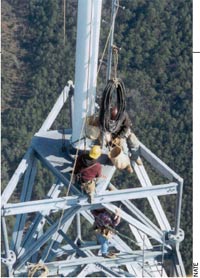A Higher Calling
When your worksite is situated hundreds of feet in the air, safety is "up to you."
 As we move closer as a nation to having a cell phone for every citizen, or at least every household, our constantly connected way of life is changing the American landscape. The tallest of the communication towers making our wireless evolution possible stretch up to 2,000 feet, a distance limited by the Federal Aviation Administration,which has determined that anything taller is a hazard to navigation. The exact number of these towers is hard to pin down because many of the antennas they support also are mounted on buildings or water towers rather than stand-alone structures. The industry’s best guess is that we now have roughly 200,000 cell towers alone. CTIA, the international association for the wireless telecommunications industry, says its figures show that number is expected to increase to 260,000 by 2010.
As we move closer as a nation to having a cell phone for every citizen, or at least every household, our constantly connected way of life is changing the American landscape. The tallest of the communication towers making our wireless evolution possible stretch up to 2,000 feet, a distance limited by the Federal Aviation Administration,which has determined that anything taller is a hazard to navigation. The exact number of these towers is hard to pin down because many of the antennas they support also are mounted on buildings or water towers rather than stand-alone structures. The industry’s best guess is that we now have roughly 200,000 cell towers alone. CTIA, the international association for the wireless telecommunications industry, says its figures show that number is expected to increase to 260,000 by 2010.
This massive addition to the national infrastructure has created a great demand for workers who are willing and able to build, retrofit, maintain, repair, and, in some cases, demolish these structures. Called tower climbers or tower hands, the men and women performing these necessary tasks are routinely required to place themselves in environments normally witnessed only from the comfort of an airplane seat (without gusts). They spend a significant part of their time perched hundreds of feet in the air.
As might be expected, risks accompany virtually every rung of their work day. Falls are the industry’s leading problem, but injuries and deaths from electrocution, inadequately guarded machinery, load impacts, and structural failures during the erection, retrofitting, or dismantling of a tower also happen.
In 1995, well before the wireless industry exploded and the towers became part of every city’s scenery, the National Association of Tower Erectors (NATE) was formed with the express goal of shaping the industry’s future. The association quickly became the leading source of education about tower safety issues for both the public and the industry itself. In 2006,NATE signed a three-year national partnership with OSHA under which participating member companies agreed to implement a series of best practices designed to increase worker safety, including 10 hours of training for all climbers and 30 hours of training for all supervisors, as well as regular site safety audits.
That partnership expires this November but may be renewed for an additional three-year term.However, if renewal depends on the program’s efficacy in reducing workplace fatalities, then OSHA could conceivably decline, opting instead for comprehensive regulation of the industry, which has so far been lacking. For in the same year the partnership began, safety advocacy group Wireless Estimator examined the industry’s on-the-job fatalities relative to the estimated number of workers and determined tower climbers had the most dangerous job in the land.
While the industry’s fatalities did decline in 2007, there were still enough for the job to be ranked one of the most hazardous. Complete data aren’t in for 2008, but in April alone, five tower climbers fell to their deaths in the span of 12 days.Overall, early estimates have not indicated what anyone would call a towering success.
Working Without a Net
On the other hand, Don Doty, chairman of NATE’s board of directors and vice president of Doty-Moore Tower Services LLC of North Wales, Pa., says the industry definitely is rallying and, due largely to efforts by NATE, becoming increasingly more safety conscious. The association’s emphasis to tower owners to hire only qualified contractors and its espousal of rigorous anti-drug enforcement programs are having a positive effect, he says, while campaigns such as “Tie or Die!” advocating 100 percent tie-off for all climbs and the more recent “It’s Up To You” public service announcements focusing on industry-wide behavior changes continue to spread the word.
Unfortunately,NATE membership is voluntary, and while the association boasts more than 500 member companies worldwide, only about a fifth of those have elected to participate in the partnership with OSHA. In the absence of a comprehensive federal standard for the tower industry, many more companies of all stripes continue to find work, while the demand for their specialized services remains high.
Telecommunications companies in general operate under thin margins, and Doty says tower projects too often are awarded to contractors who are willing to cut corners at the expense of safety to have the lowest bids. Enforcing 100 percent tie-off on all applicable jobs, for example, would prevent the falls that plague the industry, but the effort is perceived by some companies and rogue climbers as taking too long and hindering the work. The alternative, free-climbing—which is essentially working without a net— is now illegal because it too often leads to free-falling, but the practice continues.
Until tower owners and the contractors themselves decide workers’ lives are more important than budget considerations, tower climbing will remain one of the country’s most dangerous professions.“Responsible erectors figured out long ago that safety doesn’t cost money, it saves money,”Doty said. “Yes, it will take a collective effort to turn these tables. But NATE is committed to doing just that.”
This article originally appeared in the January 2009 issue of Occupational Health & Safety.